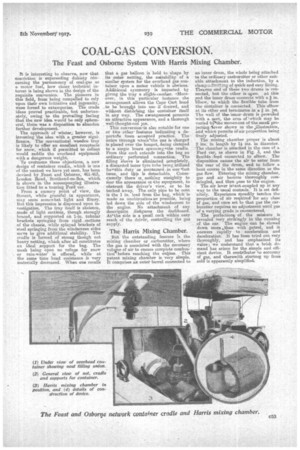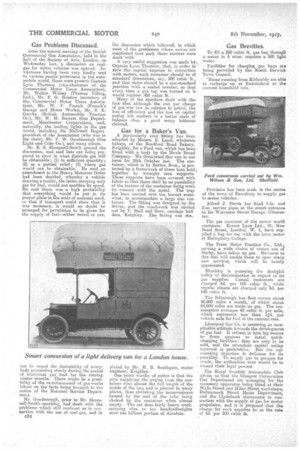COAL-GAS CONVERSION'.
Page 17

Page 18

If you've noticed an error in this article please click here to report it so we can fix it.
The Feast and Osborne System With Harris Mixing Chamber.
ft is interesting to observe now that conviction is superseding dubiety concerning the permanency of ooal-gas as a motor fuel, how closer technical interest is being shown in the design of the requisite conversion. The pioneers in this field, from being compelled to rely upon their own initiative and ingenuity, were forced to extemporize. The crude ideas proved practicable, but unfortunately, owing to the prevailing feeling that the new idea would be only ephemeral, there was a disposition to abandon forth or de v elopment. The approach of winter, however, is investing the idea with a greater significance. The conventional wooden tray is likely to offer an excellent receptacle for snow, which if permitted to collect would saddle the overhead equipment with a dangerous weight. To ovetcome these objections, a new design of container cradle, which is one of the neatest we have yet seen, has been devised by Feast and Osborne, 461-463, London B,oad, Southend-on-Sea, whicb. is shown in the accompanying illustration fitted to a touring Ford car.
From a cursory point of view, the fitment, while graceful in appearance, may seem somewhat -light and flimsy. But this impression is dispersed upon investigation. The tray itself is skeleton, made of light sections' though strongly braced, and supported oa 1-in, tubular brackets springing from rigid sections of the chassis, white splayed brackets of steel springing from the windscreen sides serve to give additional stability. The cradle is formed of strong though not heavy netting, which after all constitutes an ideal .support for the bag. The mesh being open no refuge for snow or rain-water is offered, while at the same time head resistance is very materially decreased. When one recalls
that a gas balloon is held to shape by its outer netting, the suitability of a similar system for the overhead gas container upon a motor vehicle is obvious. Additional symmetry is imparted by giving the tray a sliglateesenhee.
over, in this particular instance the arrangement allows the Cape Cart hood to be brought into useif desired, and without disturbing the container itself in any way. The alearigement presents an attractive appearance, and a thorough well-thought-out joo. This conversionds also notable:for one or tivo other' features indicating a depaetute from accepted practice. The union through tehicn"the gas is charged is .placed over the bonnet, ,being clamped to a single board spanning ',the cradle. From this cock extends into the bag an ordinary perforated connection. The filling sleeve is eliminated eompletely, a discarded inner tyre tube being:utilized forethis duty ' as mentioned, in emir +last isaue, and tbie is detachable_ Censefluently there' is, nothing unsightly to mar the appearance ot .the equipment, to obstruct the driver's view, or to be tucked away. The only pipe to be seen is the 1 in. lead from the bag, which is made as unobtrusivatae possible, being led down the side of the windscreen to the engine. No attachment of any description disfigures the dashboard.' Atethe side is a small cock within easy reach of the dri4r, controlling the gas supply.
TheHarris Mixing Chamber.
But the outstanding feature Is. the mixing chamber or carburetter, where the gas is associated with the necessary voluene of air to ensure complete combustion'before reaching the eneine. This patent mixing chamber is very simple. It comprises an outer barrel connected to an loner drum, the whole being attached to the ordinary caeburetter or other suitable attachment to the induction, by a clampealenteteng of quick and easy fitting. Tluetone end of these two drums ie connected, but the other iseope.n. at this end the inner drum connects with a
elbow, to which the flexible tube from the container is connected. This elbow at its other end terminates in a. e in. jet. The well el the. imier drum is .provided with a port, the area of ',which may be varied .1)54the movement of 'the small projecting.lever shown in the „illustration, and which permits Of airproportion being finely adjusted. The mixing chamber proper is about 2 ins, in length by 14 ins. in diameter. The chamber is attached in the case of a Ford car, as shown in Fig. 3, and the flexible ,feed connected to elbow. The disposition causes the air to enter from the rear of the drnm, and to follow a bent course in the same direction as the gas flow. Ehtering the mixing chamber, gas and air become thoroughly commingled, and then pare to the engine.
The air lever ielnot .coupled up in any way to the usual conteols. It is set definitely. Experience speedily teaches the proportion of air required' for any class of gas, and once set to that gas the carburetter requires no adjustment until gas • of a varying grade is encountered. The perfection' of the mieture is revealed very strikingly in the running of the car. The engine can be slowed clown more than with .petrol, and it answers rapidly to acceleration and deceleration. It has been tried out very thoroughly, and has emphasized its value; we understand that a brisk demand has arisen for the simple and al.rient device. It ccrntributas eo economy of gas, and therewith starting up from cold is apparently simplified.
Gas Problems Discussed.
Alter the annual meeting of the' British Commercial Gas Association, held in the hall of the Society of Arts,London, on Wednesday last, a discussion on coalgas for motor vehicleswas opened. In-' citations having been very kindly, sent to various people prominent in the automobile wprld, there were present Captain Lyon. Thomson (vice-chairman of the Commercial Motor Users Association), Mr. Walter .Wolsey (Thomas Tilling, Ltd.), Mr. F. G. Bristow (secretary of the Commercial Motor Users Association), Mr. W_ F. French (French's Garage and Motor Works), Mr. S. E. Garcke (British Automobile Traction Co.), Mr. W. M. Barrett (Gas Departmerit, Manchester Corporation.),, and, naturally, the leading lights in the gas world, including Si' Halliwell Rogers president of the Association (who was iv. the chair); -Mr. F. W. Goodenough (Gas Light and Coke Co.), and many others.
Mr. E. S. Shrapnell-Smith opened the discussion, and said lists are being prepared to show in what districts gas will be obtainable; (1) in sufficient quantity ; (2) as a partial relief; (3) where gas would not be obtainable. He said an amendment to the Heavy Motorcar Order had been decided, whereby a vehicle drawing a trailer, the latter carrying only gas for fuel, would not sacrifice its speed. He said there was a high probability that everything would be put in its proper place in the scale of national need, so that if transport could show that it was necessary, it would no doubt. be arranged for permission to be given for the supply of fuel—either neteol or gas,
hut, he urged the desirability of everybody proceeding slowly during the period of maximum gas' load for the coming winter months. There might be a possibility of the re-inforcement of gas-works labour on the facts being brought to the notice ot the National Service Department.
Mr. Goodenough, prior to Mr. Shrapnell-Smith, speak-mg, had dealt with the problems which 'still confront. us in connection with the use of coal-gas, and in
C54. ihe discussion which followed, in which moist of the gentlemen whose names are mentioned took part, these matters were . dealt with.
A very useful suggestion was made bye
• Captain Lyon Thomson, that, in order to save the capital expense in connection 'with meters, each container should be Of standard dimensions, say, 300 cubic ft., and that there should be a non-standard junction with a sealed 'counter, so that every time a gas tap was turned on it would register 300 cubic ft. • Many of the speakers dealt with the fact that although the cost per charge of gas was low in relation to petrol, the loss of efficiency' and the loss on' capital outlay left matters in a better state of balance Ahab a good many hitherto claimed.
Gas for a Baker's Van.
A particularly neat fitting hae been adopted by Messrs. E. Lund, wholeisale bakers, of the Bradford Road Bakery, Keighley, for a Ford van, which has been fitted with a body by the Hovis Bread Company. We illustrated this van in our issue for 25th October last. The container, which is by Barton Bros., is protected by a framework of three bars held I together by wrought iron supports. These supports have been covered With fabric so that there shall be no possibility of the texture of the container being worn by contact with the metal. The tray has been carried over the bonnet somewhat, to accommodate a large size container. The fitting was designed by the driver, and the coachwork was carried out by T. Steil and Sons, carriage boil ders. Keighley. The fitting was con.
pleted by Mr. H. B. Southgate, motor engineer, Keighley. One point worthy of notice is that the pipe supplying the engine from the container runs almost the full length of the inside of the bag and is pierced in many places, thus obviating the inconvenience caused by the end of the tube being choked by the container when almost empty. The car does fairly heavy work. carrying nine to ten hundredweights over the hilliest portion of Airedale.
Gas Brevities.
To fill a 250 cubic ft. gas bag through a meter in 5 mins. requires a 600 light meter. •
Facilities for charging gas bags are being provided by the North Berwick
Town Council. '
• 'Buses running from Kirkcaldy are able to recharge up at Buintisland at the current household rate. • Provision has been made be the centre of the town of Dewsbury to supply gas to motor vehicles.
Alfred J. Perris has fixed lein. and 2-in, service pipes at the street entrance to his Worcester Street Garage. Gloucester.
The gas conquest of the motor world continues. Ernest Lyon Ltd., 91, New Bond Street, London, W. 1, have supplied a bag for use with the lawn motor at Haileybury College.
The Trent Motor Traction Co., Ltd., serving a .wide choice of routes out of Derby, have taken up gas. Recourse to this fuel will enable'them to open many new services, which will be keenly appreciated.
Hinckley is pursuing the doub...tful
i
policy of discrimination n regard to its gas supplies. Casual customers are charged 4d. per 100 cubic ft.' while regular clients are charged only 3d. per 100 cubic ft.
The Edinburgh bus fleet covers about 80,000 miles a month, of which about 68,000 miles are made on gas. The consumption averages 45 cubic ft. per mile, which represents less than 1id. per vehicle mile for fuel at the current rate.
Liverpool Gas Co. is assuming an inexplicable attitude towards the development of gas fuel. It refuses to hire big meters to firms anxious to instal quickcharging facilities : they are only to be sold, and the attendant capital outlay incurred is prohibitive. But the cal-it:Mating objection is delicious for its r puerility. 'To supply gas to garages for resale, the authorities aver would be to exceed their, legal powers, , The Royal Scottish Automobile Club advise us that the Glasgow Corporation Gas Department are arranging for the necessary .apparatus being fitted at their Walls Street and Milan Street workshops, Dalmarnock Street Mains Deiaartment, and the Clydebank showrooms in connection with the supply of gas for motor propulsion, and it is proposed that the charge for such supplies be at the rate of 4d. per 100 cubic ft.






















